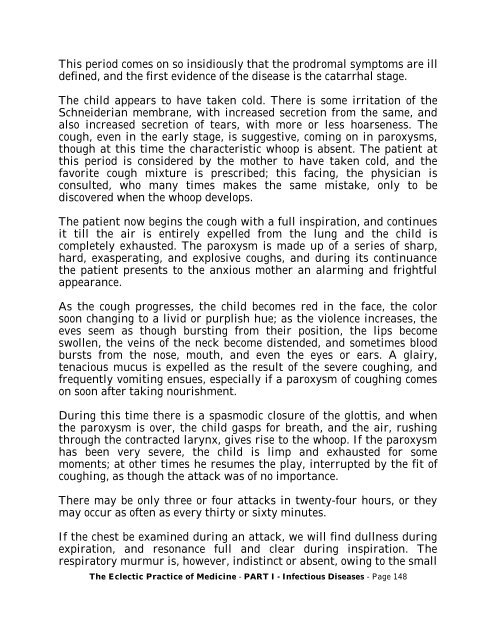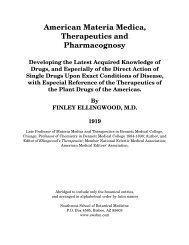SCARLET FEVER. Synonyms.—Scarlatina; Scarlet Rash. Definition ...
SCARLET FEVER. Synonyms.—Scarlatina; Scarlet Rash. Definition ...
SCARLET FEVER. Synonyms.—Scarlatina; Scarlet Rash. Definition ...
You also want an ePaper? Increase the reach of your titles
YUMPU automatically turns print PDFs into web optimized ePapers that Google loves.
This period comes on so insidiously that the prodromal symptoms are ill<br />
defined, and the first evidence of the disease is the catarrhal stage.<br />
The child appears to have taken cold. There is some irritation of the<br />
Schneiderian membrane, with increased secretion from the same, and<br />
also increased secretion of tears, with more or less hoarseness. The<br />
cough, even in the early stage, is suggestive, coming on in paroxysms,<br />
though at this time the characteristic whoop is absent. The patient at<br />
this period is considered by the mother to have taken cold, and the<br />
favorite cough mixture is prescribed; this facing, the physician is<br />
consulted, who many times makes the same mistake, only to be<br />
discovered when the whoop develops.<br />
The patient now begins the cough with a full inspiration, and continues<br />
it till the air is entirely expelled from the lung and the child is<br />
completely exhausted. The paroxysm is made up of a series of sharp,<br />
hard, exasperating, and explosive coughs, and during its continuance<br />
the patient presents to the anxious mother an alarming and frightful<br />
appearance.<br />
As the cough progresses, the child becomes red in the face, the color<br />
soon changing to a livid or purplish hue; as the violence increases, the<br />
eves seem as though bursting from their position, the lips become<br />
swollen, the veins of the neck become distended, and sometimes blood<br />
bursts from the nose, mouth, and even the eyes or ears. A glairy,<br />
tenacious mucus is expelled as the result of the severe coughing, and<br />
frequently vomiting ensues, especially if a paroxysm of coughing comes<br />
on soon after taking nourishment.<br />
During this time there is a spasmodic closure of the glottis, and when<br />
the paroxysm is over, the child gasps for breath, and the air, rushing<br />
through the contracted larynx, gives rise to the whoop. If the paroxysm<br />
has been very severe, the child is limp and exhausted for some<br />
moments; at other times he resumes the play, interrupted by the fit of<br />
coughing, as though the attack was of no importance.<br />
There may be only three or four attacks in twenty-four hours, or they<br />
may occur as often as every thirty or sixty minutes.<br />
If the chest be examined during an attack, we will find dullness during<br />
expiration, and resonance full and clear during inspiration. The<br />
respiratory murmur is, however, indistinct or absent, owing to the small<br />
The Eclectic Practice of Medicine - PART I - Infectious Diseases - Page 148

















